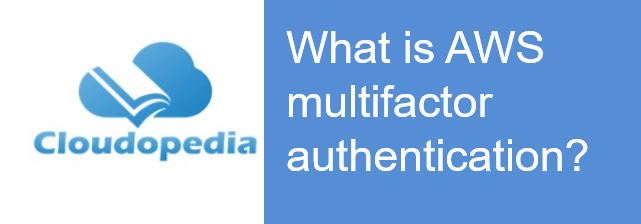What is AWS multifactor authentication ?
Definition of AWS multifactor authentication
AWS multifactor authentication (MFA) is training or requires at least two types of validation to secure AWS assets. This is an additional security highlight, accessible through Amazon Identity and Access Management (IAM), which reinforces the username and secret key certificates.
It is considered a proven practice for the MFA to be used for a root account or for “highly-favored” clients that deal with sensitive assets. It can be used for multi-account access via various AWS accounts. This is useful if your organization has different records and a trusted client must have access to all of them.
Brief Explanation of AWS multifactor authentication
To work for MFA, a virtual MFA gadget, a virtual gadget that can create a unique periodic keyword in light such as a cell phone or device gadget, must be assigned to the IAM client or the root account. The MFA gadget should be used when participating in AWS assets or when connecting to an AWS website. AWS does not charge additional costs to use the MFA when an MFA gadget is purchased. Each customer must have a unique gadget and confirmation of ownership is required by giving an important MFA code.
When MFA is authorized, the client receives a username, a secret key, and a validation code from its AWS MFA gadget when it is filed in an AWS site. The use of different record elements provides additional security for AWS assets and data set parameters.
Virtual device driver:
A virtual device driver (VxD) is a product gadget driver that mimics devices and different gadgets so that many applications that run in secure mode can access devices to push channels, device properties And storage without conflicts cause. The Vxd has been replaced by the Windows Driver Model (WDM) and is currently outdated.
PC devices require matching and control strategies for gadgets as well as equipment segments to move in a controlled manner, mainly under the control of a mix of the BIOS and the running framework. In programming, these techniques are characterized by pilot gadgets consisting of code that an application can use to access equipment or external programming capabilities. For use in multitasking scaffolds, such as Microsoft Windows, a gadget driver is controlled by the virtual device driver (VDDM) in the framework and shared by the applications running in that bit. To run legacy DOS applications in earlier forms of Microsoft Windows, the part creates a virtual machine (VM) that runs the Heritage application. Part of the DOS limitation is that it exerts total control over the equipment for product applications. This implied that running some DOS applications under a multitasking framework could cause clashes when it came to gadgets. There was no equipment gadget sharing allowed in most standard DOS applications, so the virtual device driver (VxD) was known to collaborate with known devices. PC devices require matching and control strategies for gadgets as well as peripheral parts to move towards each other in a controlled manner for the most part under the control of a mix of the BIOS and the working framework that is running.



